Hasivo S1100WP-8XGT-SE 8-port 10GbE PoE Capabilities
On the PoE side, we tested the ports with PoE, PoE+, and PoE++ devices, and what we found matched what the Fluke found, so we are just going to show those screens here. Still, something was unexpected in how the PoE was delivered. We saw something similar to the Hasivo S600-5GT 5-Port PoE 2.5GbE Switch that we reviewed. The first port does not have PoE active.
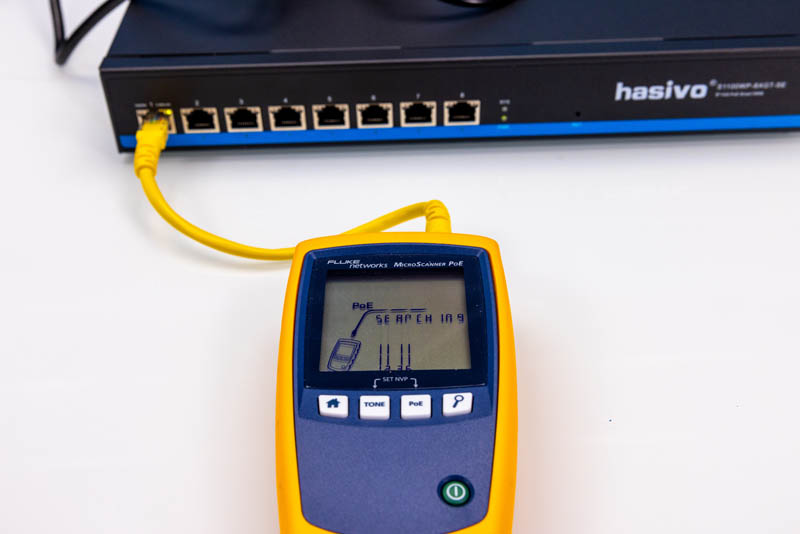
We then tried the other ports and saw our PoE+ 25.5W limits. Here is Port 2 for reference:
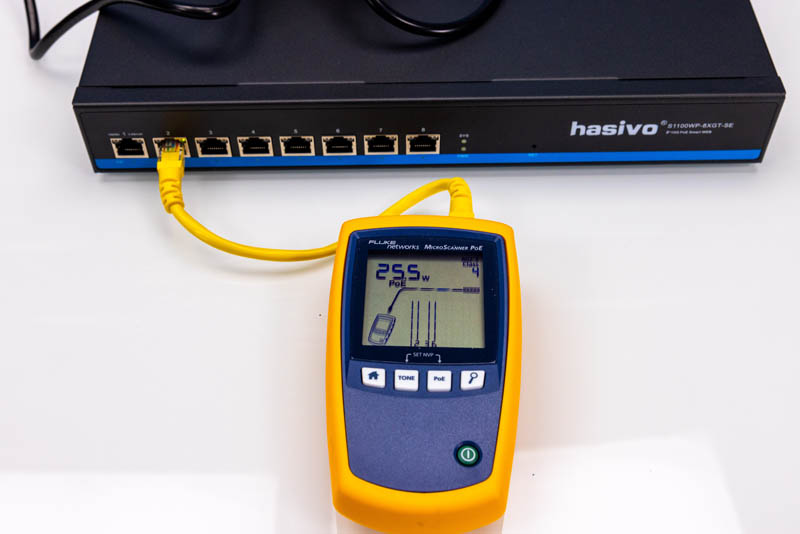
Here is Port 3:
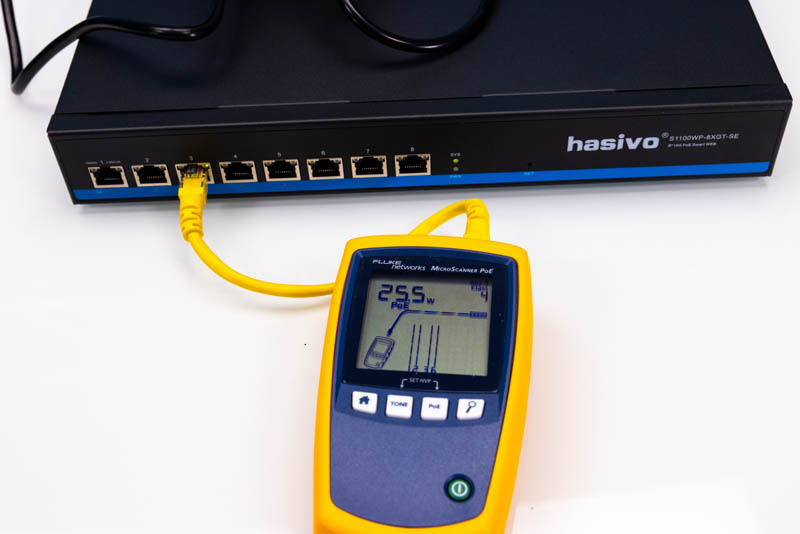
Also Port 4:
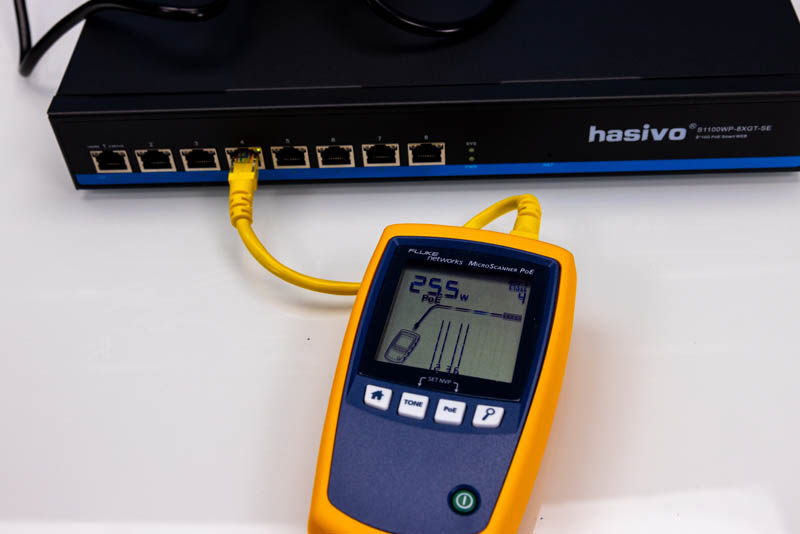
Here is Port 5:
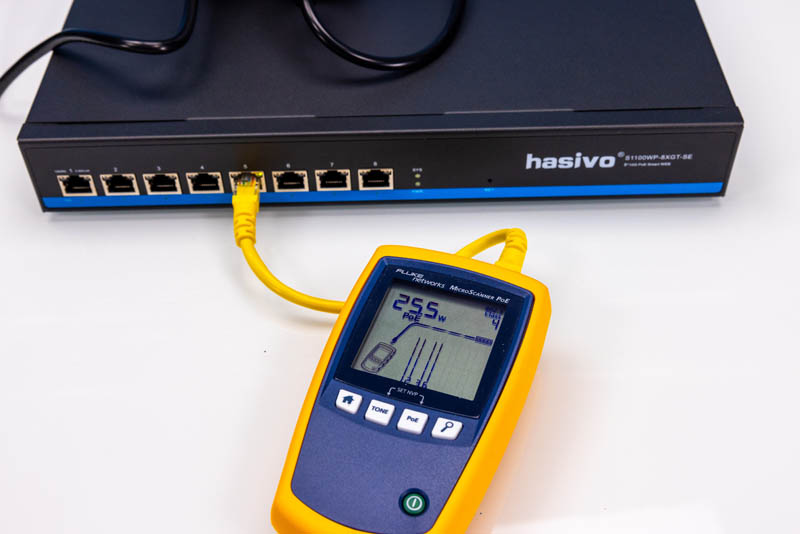
This is getting very repetitive, but we also tried the switch loaded with about 110W of PoE+ devices across 7 ports and it worked without issue.
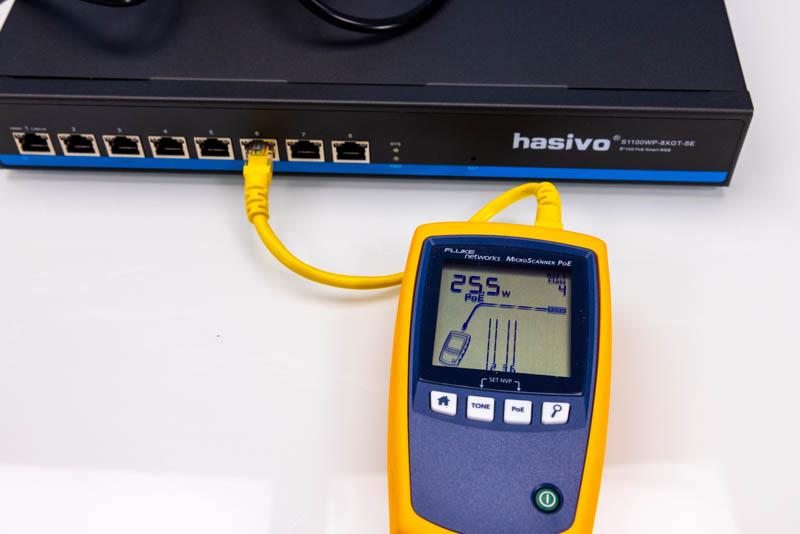
We wish these were PoE++ ports since it seems like upcoming high-end WiFi 7 APs will need that. It would also allow us to use splitters and power more devices like mini PCs using a single cable.
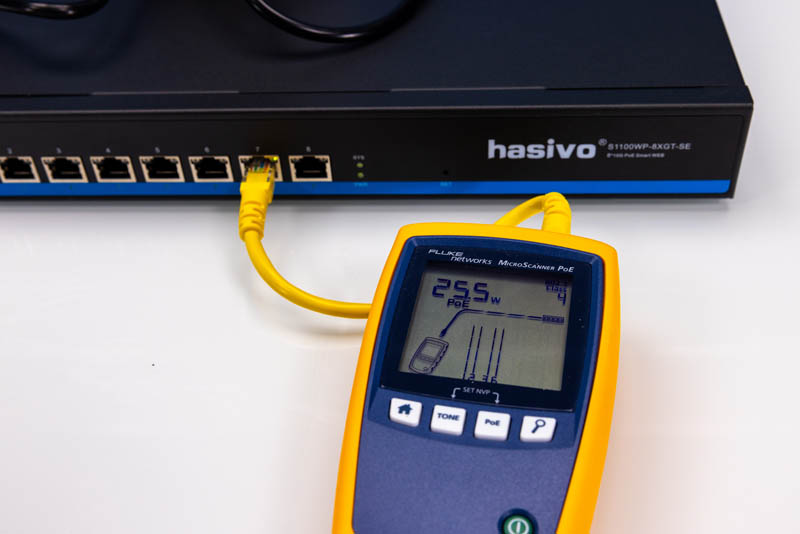
Overall the feature works across seven of the eight ports.
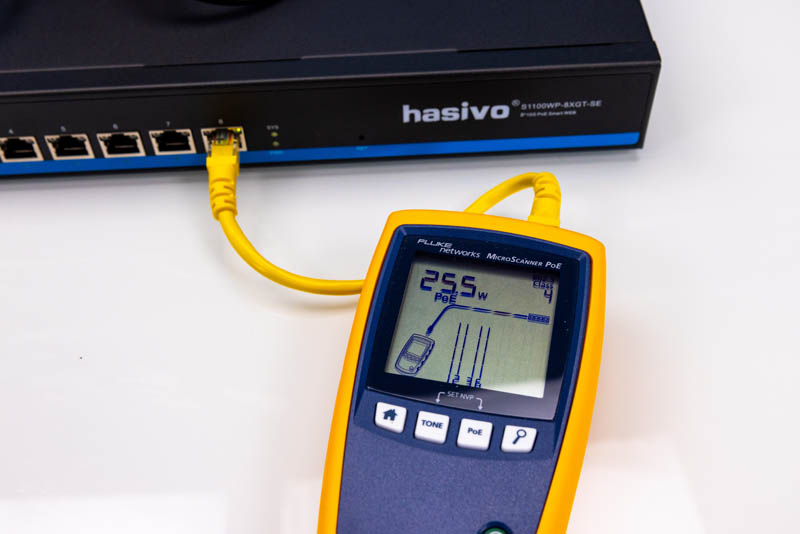
Our sense is that the first port is meant as an uplink port, and that is why it does not have PoE capabilities.
Next, let us get to the performance of the switch.
Hasivo S1100WP-8XGT-SE 8-port 10GbE Performance
In terms of the overall 10GbE performance, we were able to get fairly normal 10GbE speeds from each of the eight ports.
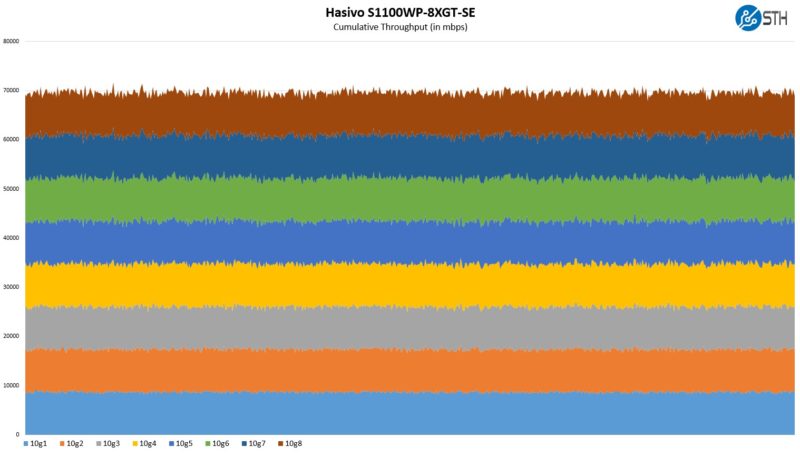
This might be a bit lower than some of the other switches we have seen, but it is fairly normal just passing traffic through a switch of this class.
Hasivo S1100WP-8XGT-SE Management Capabilities
This is a managed switch, so it had a management UI that was fairly easy to log into. The management interface was at 192.168.0.1 and the default username and password was admin.
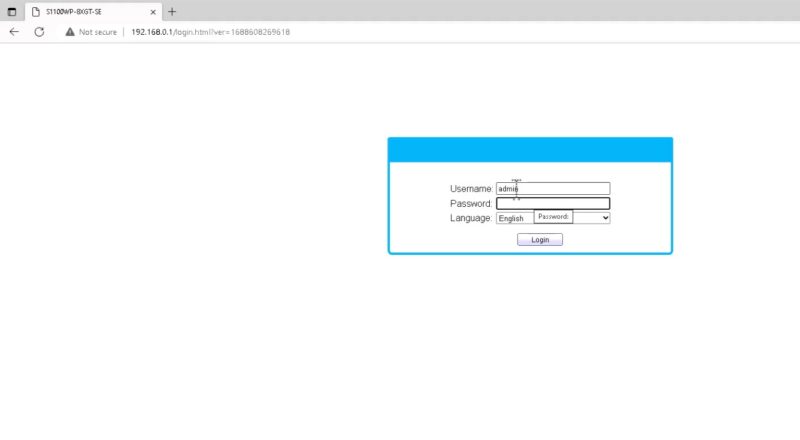
Since this is the PoE version, we have the capability to see PoE usage and limit total power usage. We can also enable/ disable the ports to power cycle PoE connected devices remotely.
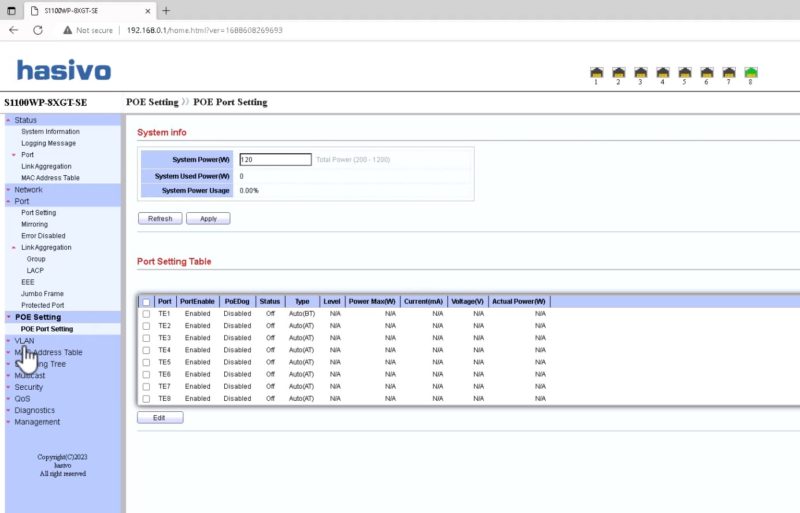
Creating VLANs is perhaps the top feature folks want with a managed switch. We can do that here.
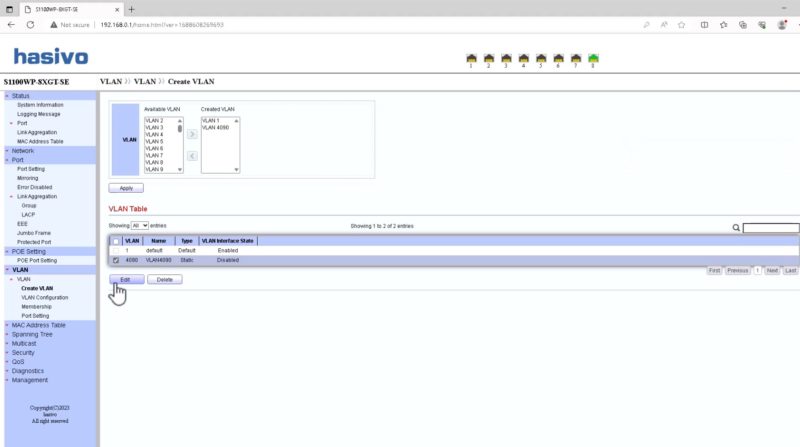
Some users have had issues with saving VLANs but this switch seemed to work.
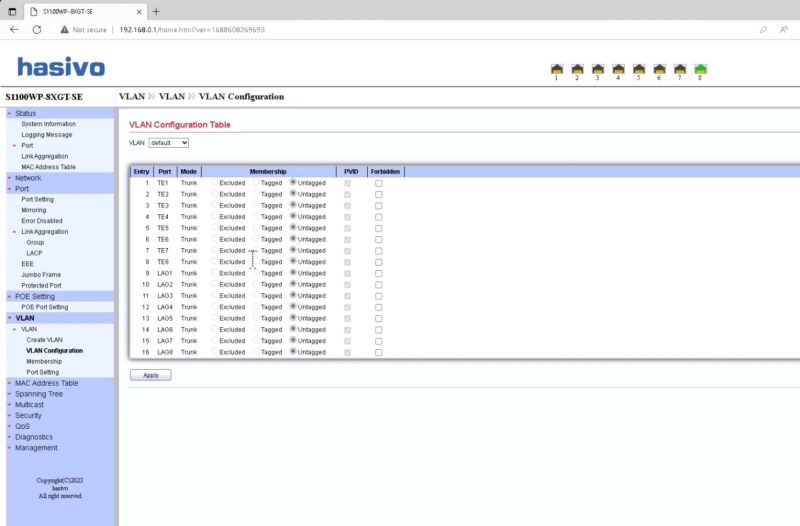
The switch also supports Spanning Tree features with lots of configuration options.
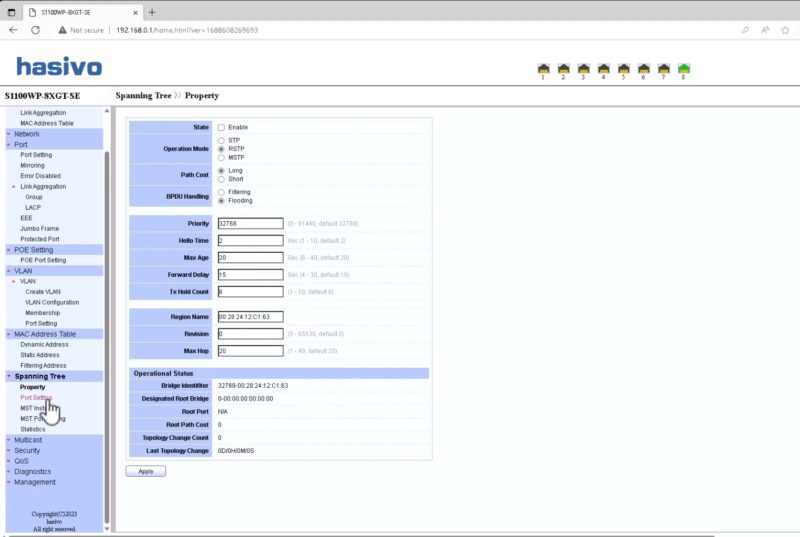
As a L3 switch, we also get QoS features.
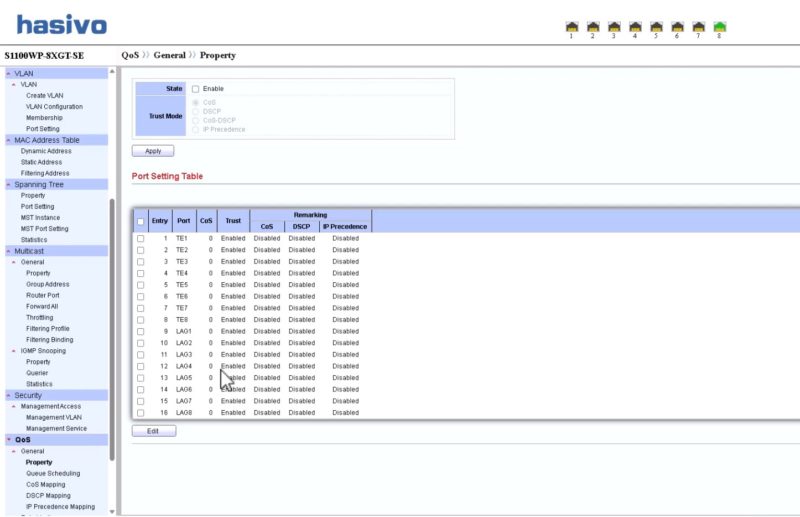
For some use cases, LACP is required, and that is a capability.
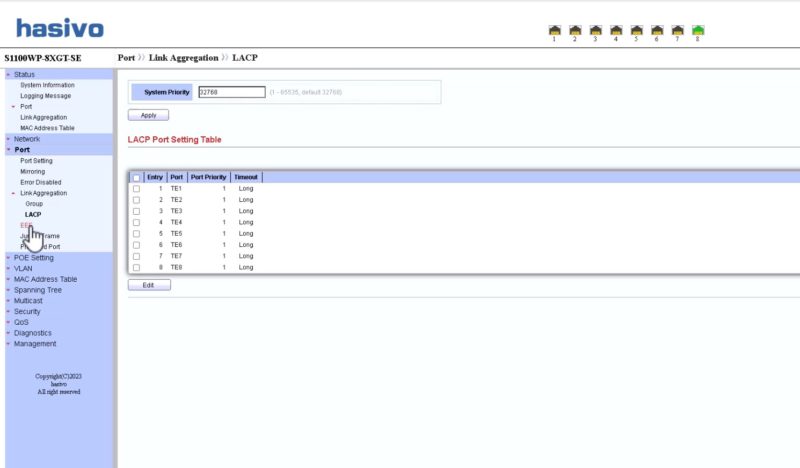
There is even a management section that had a lot more than we expected like SNMP, the ability to toggle on/off SSH access, setup users, and so forth.
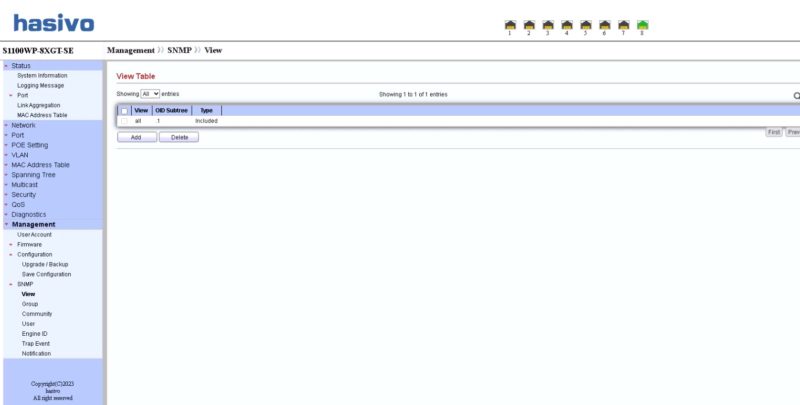
The firmware has too much for us to test in-depth in a review. One small issue we found was just doing the cable test hung on our unit. We let this sit for 12 hours and it did not succeed even on a short 2.5GbE run.
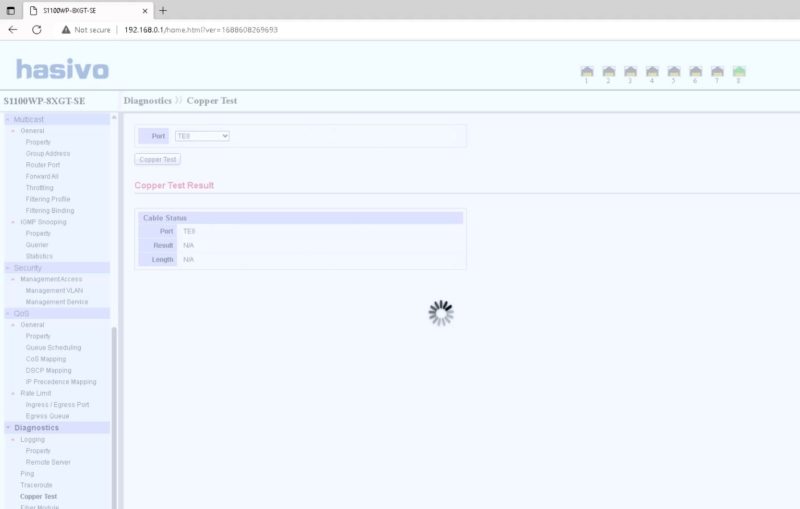
That was a bit disappointing, but it is what we found. With a switch like this, there are going to be firmware bugs, and patching is something that Hasivo will need to commit to if it wants to move up market.
Next, let us get to the power consumption and noise.




Without a reputable name brand to assure the inevitable security-related firmware updates, a managed switch in my opinion is less attractive than an unmanaged one.
A default password of admin is also not reassuring.
Are you able to do the throughput tests at various packet sizes? It’d be interesting to see the curve of total throughput by packet size for these switches. I suspect that some of the cheaper switches are going to fall off at small to medium packets
Is there a cheap 2.5GbE managed switch that anyone can suggest?
I understand that a lot of people want 2.5GbE capability, but when looking at 10GbE it seems to me that SFP+ is still a much better deal for the homelab than 10Gbase-T.
For less than this, you can get a 8 port SFP+ 10Gb switch from Mikrotik or Ubiquiti with full support — or Hasivo appears to have managed 8- and 12-port managed SFP+ 10Gb switches for $225 and $256 shipped, respectively.
Add in much more affordable secondhand SFP+ 10GbE adapters, and the total price ends up being a lot more attractive. (That seems likely to continue, as SFP+ is still strongly preferred in the enterprise environments I come across.) Something like the Horaco 2.5Gb switch reviewed recently could easily be used to add a few 2.5GbE ports for things that need them.
Don’t discount TP Link when it comes to SFP+ switches, their SX3008F is fully managed with a full Cisco-like CLI and a webGUI that has all features exposed (a rarity in my opinion), while costing similar to the Mikrotik offerings. The thing I like the most about the SX3008F though is the webGUI also has manual documentation on every page in the form of a ? button, that shows the relevant excerpt from the manual for the page you’re on.
I have the 5×2.5Gbpe + 2xSFP 10Gbe managed switch.
I think the confusion from “saving” settings is that it is required first to apply the new settings and then save configuration to “startup” config.
At least for me it took a bit to figure out.
While a bit strange, it is actually a good thing. This way it is possible to play with configuration and in case something goes terribly wrong, all that is required is to reboot the unit without need to reset it. Once desired config is working as intended, just save it to “startup” and/or “default”.
As a side note, it seems that PoE conclusions are a bit wrong. The first port is the most powerful (BT) and the rest are a bit more modest (AT) ports.
Eric Olson
This switch sits behind the router, so no real security issue.
The default password is the first thing to change.
Dakers
What you mean by cheap?
I’m not sure they have just 2.5 manged switch, but 5×2.5 + 2SFP managed PoE cost me 160$. Wich is kinda reasonable.
Dan T
The thing is that rj45 ports can offer PoE. They also use mostly existing cabling. Not to mention that most devices (and computers) do not have SFP ports. To ad 5gose, cost money.
Not to mention that non optical SFP modules with 1.2, 2.5, 5 and 10 Gbe speeds starting at around 50$ each.
So for the price of 3-4 modules, there are 5-8 ports switches.
So in my opinion for a non specific usecase, a “hybrid” switch with few of each type, is a more practical solution.
I don’t know. That Fluke can handle PoE++ so if it’s not picking it up it’s not standards compliant. Even if it works, if real test gear doesn’t recognize then I’d assume it’s not working
Finally a decent budget 10G switch! Did you test whether the PoE was isolated? If it isn’t, and you use it to power a mini PC, as soon as you plug in a monitor it will short out the switch’s power supply (if everything is earthed properly) and likely shut down the switch until the network cable (or monitor cable) is unplugged to remove the short. This limits the usefulness of PoE to only devices that don’t connect to any peripherals, like IP cameras.
Also in your power measurements it would be nice to use something like the HOPI that Big Clive (YouTube) uses as it will display things like power factor that give you a better indication of the quality of the power supply (lazy designs will have a PF closer to zero, while well designed supplies will have a PF closer to 1). In many countries businesses pay more for electricity if they run a lot of devices with poor power factor, and if a device with a poor power factor is run off a UPS, it will waste more energy as heat inside the UPS reducing battery run time, so it’s useful to know the PF for a number of reasons.
This seems like a great product to use when distributing networking to wifi 7 aps, you want more than 2.5g uplink and poe, but it is 1/4 the cost of alternate 10g poe solutions.
This review brings up too many red flags for me to even consider this product in a passing thought.
He’s missing a good uplink like a 100G port.
But for this price tag, it’s a good proposal.
Question, does it support RDMA/RoCE? I’d guess no, but it would be amazing if it did :)
Glad to see 10GBASE-T, unlike some commentors below who think SFP is better, I strongly disagree for a home 10gig network. You cannot wire your walls with DACs, Cat6a is light-years easier than fiber to install, and with 10GBASE-T you don’t have to waste money on transceivers…and that whole “sfp NICs are cheaper” isn’t true anymore….you can go on ebay right now and buy an Intel X550-T2 for $40, so unless you only need to hook up one computer that’s 3 feet from your switch, I don’t understand why anybody would prefer SFP for a home network.
@Chris L.
I’ve got fibre running across my house (next to CAT6). In euroland we have standard sized wallplates with modules 50mmx25mm that can hold audio plugs, speaker terminals, RJ45 ports, HDMI, and … OM4 sockets. Off the shelf cables just plug in the rear for the link and in the front to your device, so no termination required, the back to back connector is in the wallplate.
I went with fibre for 10G a few years back as the power consumption was hugely less (and toys like the Mikrotik CRS305 etc were *cheap*).
CAT6 is easier, but there’s still other considerations esp in europe where some countries have experienced domestic power costs of $1.50/kwh in the past year.
Following my comment above, can’t help feeling my ideal version of this would be 4x 10gbase-T, 4x SFP+ to allow a transition to 10gbaseT as multigig becomes more standard in prosumer environments. Top of the rack and replace once a winner has shown itself.
Security concerns? Maybe, but i’d never put anything not big-brand anywhere near my employers network (including Ubiquiti that I use at home).
I am not sure what audience is more pleased with this plunge into the depths of the 3rd tier network switch markets. You are pleased to find cheap switch bandwidth, home labbers are pleased to read that cheap switch bandwidth is available or you are trying to shame 2nd tier switch providers to respond with compliant gear at the same price.
Good to see copper 10000BT, the previous 10GB have been SFP+ and if you don’t have any recent experience of this area it is quite complicated, searching for it doesn’t really help. There’s also the issue of interoperability, termination of fibre etc. I’m not a network noob either, I’ve worked on 10B2, econet, RS232, RS453, token ring, Cisco cat switches in the 2000s. The SFP scene is confusing.
Why security concerns? You’re going to have it behind your firewall and I’d be locking down what can speak to the outside world etc.
Well. Thank the gods for competition from the Chinese! American vendors have been sucking the 10GBe teat for a long long long time.
2.5 GBe FFS. They’d try to offer 2.75, then 3, then 3.125, the ripoff would never end.
You shouldn’t be upset, Rohit. You should be grateful.
You should also check the XikeStor SKS7300-8GPY4XGS, no PoE, but good price and combination of 2.5 and 10G.
L2 web Managed 8 * 2.5G Switch Electrical Ports 4 * 10G Optical Ports Console Port Support VLAN & Port Aggregation
https://www.aliexpress.com/item/1005005779039887.html
Hello,
I purchased S1100WP-8GT-SE however the IP does not persist on restarting switch, making the switch completely useless, as it defaults to static IP of 192.168.0.1, has this issue been resolved in this S1100WP-8XGT-SE model?
To save the config on the S600WP, you have to specifically copy the running-config to the startup-config. I’d imagine this is the same. But until I tried the latest firmware, the S600WP wouldn’t even let me set it to dhcp, I had to telnet in to configure it.
I have this same switch here and PoE works fine on all 8 ports. I suspect yours has a fault if it wasn’t working on the first port.
I too found a lot of bugs in the firmware, including security vulnerabilities and completely nonfunctional IPv6 support. I also wasn’t able to find an updated firmware anywhere or contact hasivo via their wechat, has anyone had luck getting hold of anyone?
Great review. ty for that. so I tought to buy a cheap 10 Gbe switch, well, ali has raised the price, when i want it to send to the netherlands it costs me 37 euro around 40 dollar, but the price is now 426 euro instead of around the 250 as the initial price at the start of this article.
but i know the chinese are cheaters, so i changed my location to the usa and the currency in dollars and it was like 335 usd. what a rip off.
I start to dislike ali more and more. they are not as cheap anymore as before. and for the junk they sell compared to the prices of the real good stuff.. its not really worth anymore.
You may want to put this one up to test.
https://www.aliexpress.com/item/1005006765378093.html
HORACO 10Gb Smart Web Managed SFP+ Ethernet Switch 8 Port 10000Mbps Optical SFP+ Network Switch Home Lab Switch LACP DHCP VLAN
Just around 123 USD ???
if its good… why not
Fully agree. Here 1 year later. We need this level of features that is in accordance with the regulations and CE marked, and where it works and that cost 20-30% more in US & Europe.
I bought a Hasivo S1100WP-8XGT-SE direct from Hasivo via Aliexpress. It arrived poorly packed, and to my dismay the power switch was caved in and non-functional. Contacting them via Aliexpress messages has got me basically nowhere.
In the end I decided to void the warranty and open the device. The switch is in the power circuit via a simple spade connector, so removing it and wiring directly from power input to the PSU was straightforward.
I did get a good price, but be aware of the risks of dealing with suppliers who only sell on Aliexpress. There is no consumer protection there, and “the seller is always right”.
Just got one for $278 on AliExpress. It goes on sale . Even better since it’s the anniversary sale, AliExpress gives users a $40 coupon on large purchases. God truly loves me.